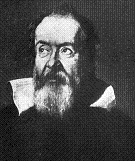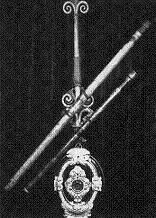
 |
|||
|
| |||
 |
Who was Galileo? And why was he important? |
 |
Galileo Galilei (1564-1642) was a Tuscan (Italian) astronomer, physicist, mathematician, inventor, and philosopher. He was born in Pisa, and was the oldest of six children in his family. When he was a young man, his father sent him to study medicine at the University of Pisa, but Galileo studied mathematics instead. He later became professor and chair of mathematics at the University. Until about 1609 he taught mathematics, and made several discoveries in physics. He helped to mathematically describe ballistics, and the force of friction as it relates to motion. After experimenting with moving objects, he established his "Principle of Inertia", which was similar to Newton's First Law.
Galileo then became interested in optics and astronomy, and in 1609 he built his first telescope and began making observations. The following year he published his first results, where he described the highlands and "seas" of the Moon, four of Jupiter's largest moons, and many newly discovered stars. He also discovered the phases of Venus and sunspots, thereby confirming that the Sun rotates, and that the planets orbit around the Sun, not around the Earth. But Galileo thought that most planetary orbits are circular in shape, when in fact they are elliptical, as shown by Johannes Kepler. Still, Galileo's observations have confirmed Copernicus' model of a heliocentric Solar System. They refuted the basic principles of Ptolemean cosmology, and put to rest Aristotle's theory that the heavens were "perfect and unchanging", which was supported by the Catholic Church. But the Church still allowed Galileo to conduct his research, as long as he did not openly advocate his findings.
In 1632 Galileo angered the Pope when he published a book in which he openly stated that the Earth was moving around the Sun. He was put on trial by the Inquisition in Rome, where he was found suspect of heresy, and forced to say that all of his findings were wrong. He was first imprisoned, and later confined to his house near Florence.
During the last ten years of Galileo's life, the Church monitored his travel and communications with others, and his writings were censored and placed in the Index of Prohibited Books. Galileo continued to write about physics, and in 1632 he put forward his concept of Basic Relativity in physics, which may be stated as follows: "the laws of mechanics will be the same for all observers moving at the same speed and direction with respect to one another." This fundamental concept later formed the basis for Einstein's Special Theory of Relativity.
Until the time of Galileo, European scientists relied largely on Aristotle's approach of philosophical analysis to explain physical phenomena. Galileo demonstrated the advantages of experimentation, and argued that physics should be a mathematics-based science. Galileo was among the scientists, including Kepler, Newton and others, who began the Scientific Revolution in Europe. Galileo's work was instrumental in advancing the scientific method. His experimentational and mathematical approach to physics was revolutionary and ahead of his time.

Did you know?
- Galileo became completely blind by the age of 74, but NOT because he looked at the Sun through his telescope. He always projected an image of the Sun onto a surface. Remember, like Galileo, you should NEVER look directly at the Sun!
- Galileo's telescopes had a magnification of only about 30x. He observed Neptune in 1612, but thought that it was a distant star. Galileo also observed Saturn's rings, but to him they appeared as two separate bodies attached to the planet.
- It is commonly believed that Galileo dropped balls of different mass from the leaning tower of Pisa, to demonstrate that they fell at the same speed. There is no historical evidence that Galileo actually did this. But it is possible that he suggested this experiment as a way to disprove Aristotle's erroneous belief that heavier objects always fell faster than lighter ones.
- Galileo attempted (unsuccessfully) to measure the speed of light by placing observers with lanterns about a mile apart.
- Galileo is credited with making the first working thermometer, though it was not very accurate.
- Galileo's father, Vincenzo Galilei, was a musician and music theorist. He helped to invent a new style of early Baroque music.

To learn more about Galileo's discoveries, try these activities!
- Take the Galileo Challenge
- Are those Sunspots Actually on the Sun? Try this activity and find out!
- A Heliocentric Solar System activity for classrooms.
- See if you can Estimate the Sun's Rotation Rate!
- Galileo's Experiments on the NOVA website (requires Flash Plugin).
- Galileoscope is a project of the International Astronomical Union (IAU). See what Galileo first saw 400 years ago!

To learn more about the life and work of Galileo, check out these links!
- The Galileo Project at Rice University.
- Galileo's Battle for the Heavens from the NOVA science website.
- Biography and Work of Galileo
- Galileo Biography
- Quotations from Galileo Galilei